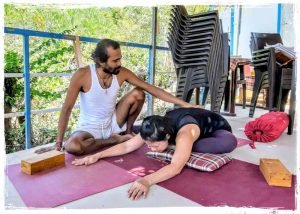Designing a yoga class

A well-designed yoga class should provide a safe, inclusive, and supportive environment where participants can explore their physical, mental, and emotional capacities and feel refreshed, energized, and rejuvenated.
ELEMENTS OF YOGA CLASS DESIGN:
- Introduction: The instructor welcomes the students and explains the purpose of the class.
- Warm-up: The students are led through a series of gentle movements to increase their body temperature and loosen up their muscles.
- Sun Salutations: A series of flowing movements to warm up the body and prepare for the main practice.
- Asanas: A series of postures, or asanas, designed to strengthen and stretch the muscles, improve balance and flexibility, and promote relaxation.
- Pranayama: Controlled breathing techniques designed to calm the mind, increase focus and concentration, and regulate the breath.
- Progressive Sequencing: The class should build up gradually, starting with simpler postures and gradually moving towards more challenging poses. This helps prevent injury and allows students to warm up and build confidence.
- Modifications and Variations: The teacher should offer modifications and variations for students of different levels, so that everyone can participate comfortably and safely.
- Attention to Alignment: The teacher should provide clear instructions and demonstrations on proper alignment, which is essential for avoiding injury and getting the most benefit from each posture.
- Breath Awareness: Yoga is a practice that links movement with breath, and a well-designed class should emphasize the connection between the two. The teacher should encourage students to focus on their breath and use it to guide their movements.
- Savasana: A well-designed yoga class should end with a relaxing period of stillness, such as Savasana. This helps students to integrate the benefits of the practice and allows them to leave the class feeling calm and refreshed.
- Mind-Body Connection: A well-designed class should emphasize the connection between movement and breath, helping students to stay present and focused, and promoting a sense of relaxation and well-being.
FACTORS THAT IMPACT YOGA CLASS DESIGN
- Level of students: The student’s skill level will determine the type and intensity of postures and sequences offered in the class.
- Goals of the class: The purpose of the class, such as stress reduction, flexibility, or strength, will dictate the types of postures and sequences used in the class.
- Class duration: The class length will affect the number of postures and sequences offered.
- Class size: The number of students in the class can impact the design, as the instructor may need to modify their approach to accommodate a larger or smaller group.
- Space and equipment: The available space and equipment will impact the design of the class and the types of postures and sequences offered.
- Style of yoga: Different styles of yoga, such as Hatha, Vinyasa, or Restorative, will have different focuses and approaches, impacting the design of the class.
- Instructor’s style: Each instructor will have a unique approach to teaching yoga, influenced by their training, experience, and personal philosophy.
- Season and weather: The season and weather can impact the type of warm-up, postures, and sequences used in the class, as well as the length of the relaxation and meditation portions.
BENEFITS OF WELL-DESIGNED YOGA CLASS:
Designing a yoga class is important for several reasons:
- Provides a Structured Practice: A well-designed yoga class provides structure and purpose to the practice, helping students to stay focused and achieve their goals.
- Supports Student Goals: By considering the needs and goals of your students, you can design a class that is tailored to their specific needs and helps them to achieve their objectives.
- Enhances the Practice Experience: A well-designed yoga class creates a seamless flow and rhythm that enhances the overall practice experience, allowing students to feel more relaxed and connected to their bodies and breath.
- Facilitates Learning: A well-designed yoga class allows students to learn about the principles and practices of yoga, including breathing techniques, meditation, and alignment, which can deepen their understanding and connection to the practice.
- Safety: A well-designed class includes poses that are appropriate for the skill level and experience of the students and provides modifications and adjustments for students with different abilities. This helps to reduce the risk of injury and ensures that students receive the benefits of yoga practice in a safe and supportive environment.
- Effectiveness: By selecting poses that align with the focus of the class and arranging them in a sequence that builds in intensity, a well-designed class can help to achieve specific goals, such as stress relief, flexibility, or strength building.
- Enjoyment: A well-designed class that flows smoothly from one pose to the next, incorporates breathing and meditation techniques, and concludes with relaxation and stretching poses, can be a relaxing and enjoyable experience for students.
- Student Engagement: A well-designed class that includes a variety of poses and that takes into account the different abilities and experiences of the students can help to keep students engaged and motivated throughout the class.
Designing a yoga class requires careful planning and attention to detail, but the effort is well worth it. By designing a safe, effective, and enjoyable class for the students, you can create a positive and rewarding yoga experience for everyone involved.
STEPS TO DESIGN A YOGA CLASS:
Designing a yoga class requires careful planning and attention to detail, as well as an understanding of the principles and practices of yoga. Here are some steps to help you design a yoga class:
- Determine the Focus of the Class: Consider the goals and needs of your students, and choose a focus for the class that aligns with these goals. For example, you could design a class focused on stress relief, flexibility, or strength building.
- Select Appropriate Poses: Choose a series of yoga poses that support the focus of the class, taking into account your student’s skill level and experience. Make sure to include a variety of standing, seated, and supine poses.
- Consider the Sequence: Plan the sequence of poses so that they flow smoothly from one to the next, building in intensity as needed. Begin with warm-up poses, move into more challenging postures, and conclude with relaxation and stretching poses.
- Incorporate Breathing and Meditation Techniques: Yoga is not just about physical poses but also breathing and meditation techniques. Incorporate these elements into your class to create a well-rounded student experience.
- Time Management: Plan the class to run for the desired length, considering the required time for each pose and transitions between poses.
- Plan for Modifications and Adjustments: Make modifications and adjustments for students with different abilities, and be prepared to offer hands-on assistance if needed.
- Practice the Sequence: Take time to practice the class sequence, paying attention to the flow and timing of each pose. This will help you refine the class and ensure it runs smoothly.
By following these steps, you can design a yoga class that is safe, effective, and enjoyable for your students.
FAQ ON YOGA CLASS DESIGN
Q: What is the purpose of a yoga class design?
A: The purpose of a yoga class design is to create a structured and effective practice that meets the needs of the students and supports their physical, mental, and emotional well-being.
Q: What factors should be considered when designing a yoga class?
A: When designing a yoga class, it’s important to consider the level of experience and physical ability of the students, the theme or focus of the class, the amount of time available, the location of the class, the instructor’s training, and style, and the season and weather.
Q: What is the typical structure of a yoga class?
A: A typical yoga class typically includes an opening, warm-up, sun salutations, asanas, pranayama, meditation, relaxation, and closing.
Q: What are the benefits of a well-designed yoga class?
A: The benefits of a well-designed yoga class can include improved physical, mental, and emotional well-being, increased self-awareness and self-acceptance, reduced stress and anxiety, and a sense of community and connection with others.
Q: What is the importance of the warm-up in a yoga class?
A: The warm-up is essential in a yoga class because it prepares the body for the main practice, reduces the risk of injury, and helps students focus and feel more comfortable and relaxed.
